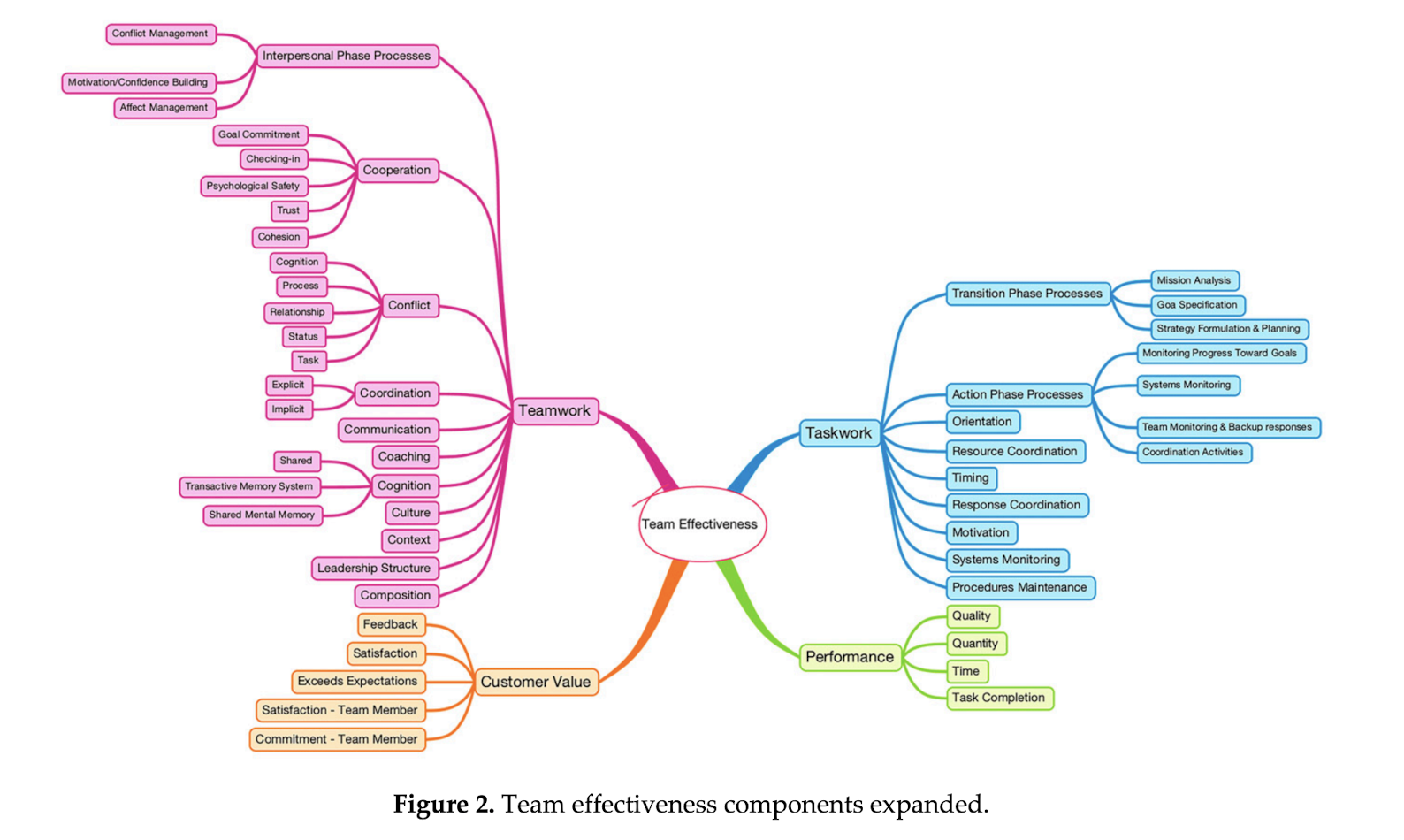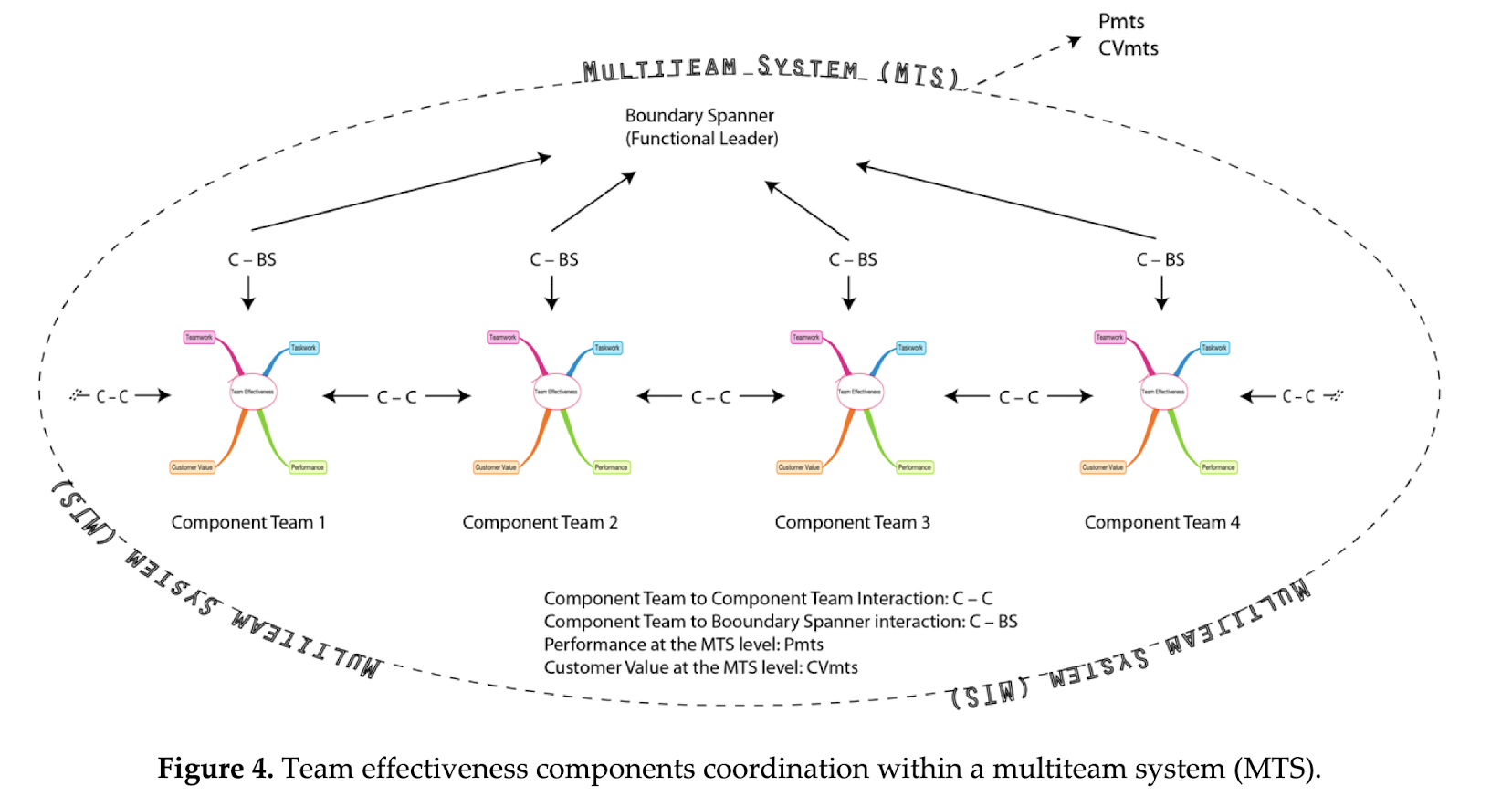Michael Shulman's Shared Notes
Powered by 🌱Roam GardenArticle:Turner, et al. (2020) MTS Effectiveness Model
- Type:: Article
- Authors:: John Turner Rose Baker Ali Zain Nigel Thurlow
- Journal:: Systems
- Reading Status:: QuickerRead
- DTlink:: link
- Date:: 2020
- Tags:: article MTS performance
- Related::
- Full citation:: Turner, J., Baker, R., Ali, Z., & Thurlow, N. (2020). A New Multiteam System (MTS) Effectiveness Model. Systems, 8(2), 12. https://doi.org/10.3390/systems8020012
- Found From/Recommended By:: fromSteve
- Abstract highlights:
- Develop a new framework for MTS effectiveness, using a "narrative-based method for theorizing" to build on a review of team effectiveness frameworks and models.
- Understanding is that teams manage their own teamwork and taskwork activities, and that leaders coordinate those activities within and between teams.
- Teamwork = "interpersonal, effective, motivational, cognitive" activities
- Taskwork = "strategy, goal setting, project management" activities
- Formula includes team and MTS level components
- Other points:
- Article really built around the understanding of MTSs as appointed, rather than emergent. Has some odd assumptions and weird ways of seeing things - like that each team has a distal goal that can be the same or different than other teams, and that its proximal goals are how they will reach that; that proximal goals are reached through shared leadership, and distal goals by functional leaders (which is said to be about leader-team rather than leader-follower interactions) or boundary spanners, which would result in a totally different goal hierarchy than we would build.
- Reading Notes
- Intro
- Team performance and team effectiveness are not the same thing
- Team effectiveness is when "team's processes align with external task demands" (pg. 1), and are optimized when reach goal. It's not just a function of performance outcome - it's about things like design factors of the task/group/organization, about internal and external processes, about psychosocial traits and environmental factors. It's about coordination, cooperation, and communication. It's about the competencies of team members, about "regulation, performance dynamics, and adaptation."
- Team performance is about what the team does. Behaviors and outcomes that are judged by others. Performance is compared to a predetermined standard, measured by something like productivity, quality, quantity, time.
- Q: Why is productivity an outcome measure of performance rather than effectiveness?
- Team effectiveness includes team performance as part of its metric - it's the outcome, and the processes used to reached it.
- Teams are complex and multilevel, and have been research calls for understanding them as such.
- Team performance and team effectiveness are not the same thing
- Review method:
- Pulled reviews of team effectiveness; and articles with team effectiveness and multiteam
- Researchers selected articles to synthesize into common framework: 8 on team effectiveness, 12 on team process models and emergence, 6 on common team-based models
- Team Effectiveness, overview
- Team effectiveness, Process-type models (like IPO)
- Emergent States
- Common team-based models
- Ilgen et al (2005)
- Marlow et al. (2018), MTSs in healthcare
- Magpili and Pazos, (2018), SMT
- Zaccaro and Shuffler, MTS Effectiveness (from 2012 book chapter intro, and Shuffler et al.'s 2015 review - not the 2018 one)
- Shuffler et al. (2015), MTS intra- and inter-team processes and outcomes
- Marks et al. (2011) Taxonomy of Team Processes
- MTS Team Effectiveness, overview
- Team Effectiveness Formula
- Measured at team level: Components of teamwork, taskwork, outcome/performance, and value to customer.
- This model expands when you account for Marks et al.'s (2005) ttemporal processes - transition phase, action phase, interpersonal processes.
- They actually show this as a mindmap, not just as a table. Much more effective!

- They actually show this as a mindmap, not just as a table. Much more effective!
- Team Effectiveness Formula
- MTS Effectiveness Model
- To conceptualize MTS-level for this study, they look at functional leadership or boundary spanners. Interesting thought, not convinced yet assumption
- (In differentiating functional leadership, say it's about leader-team rather than leader-follower interactions.) Interesting odd
- Have leadership of team towards proximal goals as shared, and of MTS towards distal goals as boundary spanners or functional leadership. This is not a conceptualization I find useful. disagree
"The component team’s distal goals could be the same as other component teams, but they are often different, each contributing to the overall objective of the MTS." (pg. 10) odd
- Transition processes - distal goal for team is set by boundary spanner (leader), then team goes through strategy formulation to figure out how to reach that - those are then their proximal goals (What would these proximal goals look like in a goal hierarchy?) odd
- Action processes - boundary spanner is not involved in daily workings of component team, except for providing organizational resources. So this is on shared leadership. odd disagree
- Interpersonal Processes - all are involved in this, leaders (boundary spanners) and team members
- To conceptualize MTS-level for this study, they look at functional leadership or boundary spanners. Interesting thought, not convinced yet assumption
- Final MTS Effectiveness multilevel formula (changed the notation from how they put it, to be more readable to me)
- MTSeffectiveness = (component team to component team interactions) + (component team to boundary spanner interactions) + (MTS performance) + (MTS-level Customer Value) + (SUM ComponentTeamEffectiveness)
- TeamEffectiveness = (TeamWorkWork + InterpersonalPhase) + TaskWork(TransitionPhase + ActionPhase) + Performance + CustomerValue

- Intro